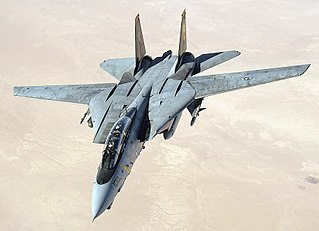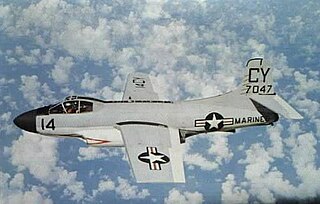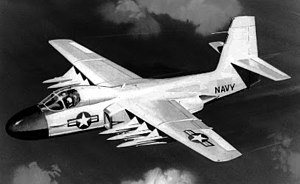
The AIM-54 Phoenix is an American radar-guided, long-range air-to-air missile (AAM), carried in clusters of up to six missiles on the Grumman F-14 Tomcat, its only operational launch platform.

Fighter aircraft are military aircraft designed primarily for air-to-air combat. In military conflict, the role of fighter aircraft is to establish air superiority of the battlespace. Domination of the airspace above a battlefield permits bombers and attack aircraft to engage in tactical and strategic bombing of enemy targets.

The Grumman F-14 Tomcat is an American carrier-capable supersonic, twin-engine, two-seat, twin-tail, all-weather-capable variable-sweep wing fighter aircraft. The Tomcat was developed for the United States Navy's Naval Fighter Experimental (VFX) program after the collapse of the General Dynamics-Grumman F-111B project. A large and well-equipped fighter, the F-14 was the first of the American Teen Series fighters, which were designed incorporating air combat experience against MiG fighters during the Vietnam War.

An interceptor aircraft, or simply interceptor, is a type of fighter aircraft designed specifically for the defensive interception role against an attacking enemy aircraft, particularly bombers and reconnaissance aircraft. Aircraft that are capable of being or are employed as both ‘standard’ air superiority fighters and as interceptors are sometimes known as fighter-interceptors. There are two general classes of interceptor: light fighters, designed for high performance over short range; and heavy fighters, which are intended to operate over longer ranges, in contested airspace and adverse meteorological conditions. While the second type was exemplified historically by specialized night fighter and all-weather interceptor designs, the integration of mid-air refueling, satellite navigation, on-board radar and beyond visual range (BVR) missile systems since the 1960s has allowed most frontline fighter designs to fill the roles once reserved for specialised night/all-weather fighters.

The General Dynamics F-111 Aardvark is a retired supersonic, medium-range, multirole combat aircraft. Production models of the F-111 had roles that included attack, strategic bombing, reconnaissance and electronic warfare. The name Aardvark was derived from perceived similarities of the aircraft to the animal: a long nose and low-level, terrain-following capabilities. The word "aardvark", from the Afrikaans contraction "earth-pig", was the source of the F-111's nickname of "Pig" during its Australian service.

The Grumman A-6 Intruder is an American twinjet all-weather attack aircraft developed and manufactured by American aircraft company Grumman Aerospace and formerly operated by the U.S. Navy and U.S. Marine Corps.

The LTV A-7 Corsair II is an American carrier-capable subsonic light attack aircraft designed and manufactured by Ling-Temco-Vought (LTV).

The Douglas F3D Skyknight is an American twin-engined, mid-wing jet fighter aircraft designed and manufactured by the Douglas Aircraft Company.

The North American XF-108 Rapier was a proposed long-range, high-speed interceptor aircraft designed by North American Aviation intended to defend the United States from supersonic Soviet strategic bombers. The aircraft would have cruised at speeds around Mach 3 with an unrefueled combat radius over 1,000 nautical miles, and was equipped with radar and missiles offering engagement ranges up to 100 miles (160 km) against bomber-sized targets.

The Pratt & Whitney TF30 is a military low-bypass turbofan engine originally designed by Pratt & Whitney for the subsonic F6D Missileer fleet defense fighter, but this project was cancelled. It was later adapted with an afterburner for supersonic designs, and in this form it was the world's first production afterburning turbofan, going on to power the F-111 and the F-14A Tomcat, as well as being used in early versions of the A-7 Corsair II without an afterburner. First flight of the TF30 was in 1964 and production continued until 1986.

The Hughes AIM-47 Falcon, originally GAR-9, was a very long-range high-performance air-to-air missile that shared the basic design of the earlier AIM-4 Falcon. It was developed in 1958 along with the new Hughes AN/ASG-18 radar fire-control system intended to arm the Mach 3 XF-108 Rapier interceptor aircraft and, after that jet's cancellation, the YF-12A. It was never used operationally, but was a direct predecessor of the AIM-54 Phoenix used on the Grumman F-14 Tomcat.
The Grumman G-118 was a design for an all-weather missile-armed interceptor aircraft for use on US Navy aircraft carriers. Originally conceived as an uprated F11F Tiger, it soon evolved into a larger and more powerful project. Although two prototypes were ordered in 1955, development was cancelled the same year in favor of the F4H Phantom II before any examples were built. Grumman's next carrier fighter would be the F-14 Tomcat, ordered in 1968.

An air superiority fighter is a fighter aircraft designed to seize control of enemy airspace by establishing tactical dominance over the opposing air force. Air-superiority fighters are primarily tasked to perform aerial combat against agile, lightly armed aircraft and eliminate any challenge over control of the airspace, although some may have a secondary role for air-to-surface attacks.

The AN/AWG-9 and AN/APG-71 radars are all-weather, multi-mode X band pulse-Doppler radar systems used in the F-14 Tomcat, and also tested on TA-3B. It is a long-range air-to-air system capable of guiding several AIM-54 Phoenix or AIM-120 AMRAAM missiles simultaneously, using its track while scan mode. The AWG-9 utilizes an analog computer while the APG-71 is an upgraded variant utilizing a digital computer. Both the AWG-9 and APG-71 were designed and manufactured by Hughes Aircraft Company's Radar Systems Group in Los Angeles; contractor support was later assumed by Raytheon. The AWG-9 was originally created for the canceled Navy F-111B program.

The General Dynamics–Grumman EF-111A Raven is a retired electronic-warfare aircraft designed to replace the EB-66 Destroyer in the United States Air Force. Its crews and maintainers often called it the "Spark-Vark", a play on the F-111's "Aardvark" nickname.
VFAX for Naval Fighter Attack Experimental was actually two specifications for two US Navy fighter projects. The first was for a low cost lightweight complement for the General Dynamics–Grumman F-111B which could replace the McDonnell F-4 Phantom II for air superiority, escort, and ground attack missions in the early 1960s. This role was dropped in favor of the VFX aircraft, which emerged as the F-14 Tomcat. The second VFAX evolved when the VFX proved too costly to replace all existing USN fighters and attack aircraft, and the Navy was invited to take part in the USAFs Lightweight Fighter Program (LWF). The Navy chose the YF-17, the loser of the LWF contest as its Navy Air Combat Fighter, as it was inherently more suitable to naval operations than the winning General Dynamics F-16 Fighting Falcon; it was redesigned to become the McDonnell Douglas F/A-18 Hornet.

The General Dynamics–Grumman F-111B is a former long-range carrier-based interceptor aircraft planned as a follow-on to the F-4 Phantom II for the United States Navy (USN).

The Mitsubishi F-15J/DJ Eagle is a twin-engine, all-weather air superiority fighter based on the McDonnell Douglas F-15 Eagle in use by the Japan Air Self-Defense Force (JASDF). The F-15J was produced under license by Mitsubishi Heavy Industries. The subsequent F-15DJ and F-15J Kai variants were also produced. Japan is the largest customer of the F-15 Eagle outside the United States. In addition to combat, F-15DJ roles include training. The F-15J Kai is a modernized version of the F-15J.

The AAM-N-10 Eagle was a long-range air-to-air missile developed by the Bendix Corporation for use by the United States Navy. Intended for carriage by the Douglas F6D Missileer fleet defense fighter, the Eagle program was cancelled before testing could begin, but the lessons learned were used in the development of the AIM-54 Phoenix missile.



















